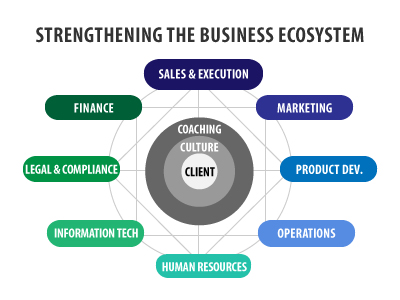Are you wondering why your networking efforts aren’t producing leads? Have you made the personal investment in attending networking events, and holding follow-up 1:1’s, but you can’t quite seem to create productive business relationships?
If that sounds familiar, you are certainly not alone. I’ve built my business largely through referrals, but it didn’t start that way. I invested lots of time and effort in “networking”, and often wondered how long it would take to pay off.
It took time to build a broad network of referral partners and resources that I felt confident recommending to my clients and others within my network.
By placing my focus on serving my clients and colleagues, reciprocating referral relationships naturally formed. As I look back at my own journey, I learned a lot in the process.
I’m happy to share my experience in hopes that it will help as you continue building your own network. Here are 5 areas I’ve found to be key in creating impactful referral partner relationships.
1 – Establish Trust & Credibility
Before a productive relationship can begin, there must be a foundation of trust based on authenticity, and a belief in one another’s credibility.
I find I usually get a sense for this in our initial meeting…..Do they represent themselves well? Act and talk professionally? Do I envision them projecting credibility if I were to refer them to a client? If I am at all skeptical, I typically don’t invest additional time exploring the relationship. Networking is about finding the right match, not force fitting when alignment is off.
After I feel a good sense of trust, I shift my focus to validating that they are truly the subject matter expert that they claim. I will usually ask some pointed questions about their background or experience. Giving a test of sorts to see how they think about things and if their answers truly demonstrate expertise in their field.
2 – Find Proper Alignment
Alignment screening starts with verifying that there is ample overlap in the client environments we both focus on. We won’t be effective at sharing leads with one another if we aren’t playing in the same sandbox. Some of these things can be researched ahead of time but a good portion cannot.
For example, I seek networking partners focused on B2B small-to-mid sized businesses whose relationships are with C-level contacts.
Those specialized in any of the core areas shown on my Business Ecosystem illustration tend to nicely complement my Sales focus. The other critical area I careful explore is that our values and philosophy are aligned. A strong fit in those areas gives me confidence that we can work through any challenge that may arise in a shared client setting.

3 – Articulate How You Help
One of the most important parts of networking is being able to quickly relay your expertise. If the networking partner asks you for more information related to your field, don’t be afraid to flex a little bit. Show off that you have serious skill when it comes to your field and you’re able to jump in and use it.
What I’ve found works well is to share a client success story. I’ll outline the client’s problem that prompted my involvement and share the corrective action roadmap that I developed to address the underlying root issues. Ultimately, I share a before and after snapshot of the client’s experience.
Stories are memorable and when meeting so many people each week, stories stand out. They help the referral partner quickly connect the dots between your specialization and the needs of their clients and associates.
Another technique is dropping your new contact an article you’ve written that also relays how you help. For example, one of my go-to articles is, “Can Fractional Sales Leadership Help Me Get Ahead?”.
4 – Demonstrate Effective Communication
When you are in the early stages of developing a new referral relationship, effective communication and follow-up are key.
If someone isn’t committed to following through on next steps that were agreed upon, or doesn’t communicate in a professional manner, then the chances of turning that relationship into more than just acquaintances are very low.

Another factor to assess is the new contact’s communication style and temperament. Do they listen carefully and respond to inquiries on-point both verbally and in written format? Do they seem adaptable to handle varying client personalities?
I don’t want to refer someone who is difficult to work with that could potentially leave a bad taste in my client’s mouth.
I’ve found that referral partners with high levels of integrity will be cautious about who they associate with, especially when it comes to those they invite into their client settings. It’s important to understand the way an associate performs is a direct reflection on the person who introduced them.
5 - Be Intentional
Being intentional in your networking can mean different things depending on the nature of your product, average transaction size, etc. Your networking development focus may be narrow and specific or broad and wide to achieve your objectives. For some, attending general networking events held by a Chamber of Commerce may be beneficial. For others, it may be more worthwhile to attend events targeted to a more specialized audience.
Networking takes time and developing mutually beneficial relationships is an even bigger commitment. You need to maintain a sizable list of networking targets and be committed to investing the necessary time to isolate those that have strong potential. After all, where you really get a return on your time investment is by going deeper with networking partners who have alignment in the areas I mentioned.
Key Takeaways
- Networking is a valuable activity when it’s done right.
- Invest more deeply in qualified contacts with strong alignment.
- Take the time to learn how the referral partner helps their clients.
- Developing new relationships with a serving mindset, this is a two-way street.
If you’d like to discuss additional ways your salespeople can sharpen their skills to generate and convert more leads, contact me at [email protected].
I also invite you to follow me on LinkedIn to gain exposure to future article posts that will offer more valuable selling insights.
I am part of a national group of Senior Sales Leaders who collaborate to share insights like the examples shown in this article. We formed because of our shared passion to help business leaders exponentially grow their revenue.
